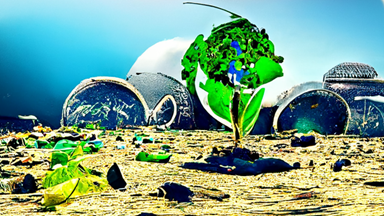Small Scales and Large Impacts: an interactive story
In this post, Samuel Pegg – a finalist English student and one of our interns at Southampton Digital Humanities – describes the rationale behind “Small Scales and Large Impacts”, an interative story created during his internship.
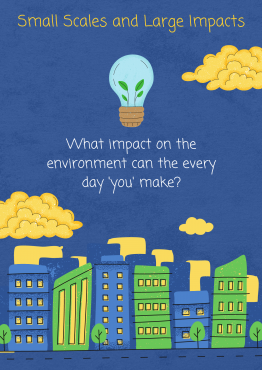
Small Scales and Large Impacts (known as Small Scales from this point on) is an interactive storytelling experience – published at https://biglittleinteractive.itch.io/small-changes-large-impacts – that seeks to empower the small-scale decisions we make about the environment that have the potential to have large impacts (hence the name).
It puts you in the shoes of a second-person protagonist who must make a multitude of small decisions that have impacts and consequences that affect the rest of the narrative. In a choose-how-you-play format, Small Scales uses the software Twine to create a basic point and click adventure that feeds into a machine that can paint, to create an outcome based on the decisions the player makes. The idea behind the project is to educate people on their day-to-day decisions surrounding the environment, but also to provide them with a unique outcome that only our machine could achieve. Whether the player is incredibly aware of environment crisis or completely oblivious, Small Scales is designed to be unobtrusive and educational rather than moralising and judgemental.
Narrative Structure
Small Scales is built around two core paths and four main variables that make up the narrative. ‘Short-play’ is a 5-minute experience around plastic bottles and recyclable waste. ‘Long-play’ takes elements of ‘Short-play’ (recycling all the content) but adding a more comprehensive and larger narrative around it that is largely inspired by the story of Afroz Shah (the man behind the world’s largest beach clean-up). While ‘Short-play’ has 4 separate endings, ‘Long-play’ has a possible 7, which all feed into our machine that can paint (but more on that later).
|
Possible Endings: 1- A beach covered in plastic bottles and litter [long-play only] 2- A landfill dump filled with carboard boxes 3- A landfill dump filled with plastic waste and bottles 4- An eco-planet thriving on vegetation and plants 5- A planet cleaned of waste and free of space 6- A person by themselves cleaning the beach [long-play only] 7- A clean beach with plastic bottles landfills standing high in the background [long-play only] |
The idea of these narratives is to confront the player with decisions they can make on a day-to-day basis, varying from the incredibly mundane decisions of “to pick up a bottle on the floor or to leave it” to the larger idea of “starting a beach clean-up scheme”. However, these decisions are built around research and genuine impacts they can have – focusing on empowering the small decisions that an individual can make rather than aspiring to the ones that need to be made on a corporate level. Empowerment then is a keyword for this project.
Variables
The project also makes use of four main variables or “influences” that determine the outcome of your story and open-up or close certain narrative decisions. These four mechanics are: ‘Green’, ‘Moral’, ‘Absurd’ and ‘Awareness’. Each mechanic works as follows:
GREEN – This variable measures the decisions which fit in with a “greener” or “eco-friendy” lifestyle. Its value starts at 0. Decisions that would positively affect the environment increase the variable (varying from +1 to +3) while negative decisions would decrease the variable (varying between -1 and -2). Certain pathways are locked behind a GREEN wall which requires players to have a certain number or higher to be able to see and make that choice.
MORAL (Long-play only) – This variable measures the decisions which are morally grounded and conscientious towards others. They don’t always affect the environment, but they the effect of judging how likely you would go out your way to achieve a certain outcome. Its value starts at 0. Much like GREEN, certain pathways are locked behind needing a certain value or higher. These decisions often influence how you interact with other people in the narrative.
AWARENESS – A variable which rewards players for being curious about their surroundings (especially in the long-form text areas), for showing an interest in aspects of the narrative which may not contribute entirely to the story but are genuine problems we can face in our day-to-day life. Its value starts at 0. Greater scores in awareness unlock certain passages of description, filling in certain blanks that you wouldn’t otherwise notice.
ABSURD – This variable was added to give the story a lick of humour. It measures the decisions we think about making but most likely wouldn’t make. Its value starts at 0. Having a high absurd value allows you to bypass certain parts of the narrative that are designed to challenging and even slightly dull. It rewards out-the-box thinking.
Path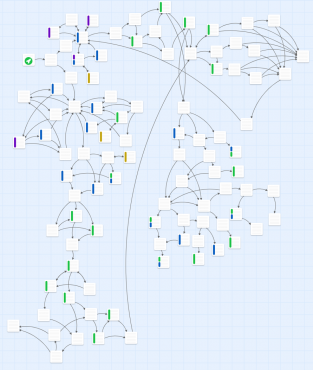 ways
ways
While four variables don’t sound all that much, when combined they create a complex spider-web of decisions being opened and locked out for the player. This creates a high level of variability to each playthrough that means everyone has at least some variation to what they experience (more notable in Long-play). To see all the decisions and the variables they correspond to, I have provided a colour-screenshot of the Twine game in its mind-map format to the right of this paragraph.
Endings
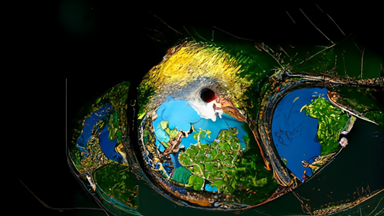
Perhaps the project’s most unconventional element can be found in its conclusion, whereby the game’s different endings are converted into inputs for a machine that generated images from textual prompts. This element of the project was undoubtedly its most important because with seven endings, there needed to be something that meant no ending was the same. To achieve this, we built on notebooks created by Elea
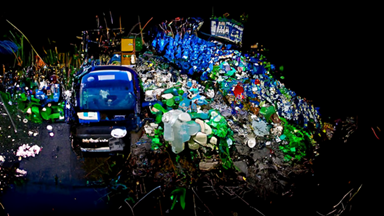
Zhong that use an AI based image generator called Pixray. The AI responds to textual prompts and attempts to draw images that represents those prompts. Far from mechanistic the effect is often surreal, uncanny and oddly beautiful.
Significantly for this project, each image generated by the machine is unique, meaning that the same input will generate a unique output.
For example, both the images below were created from the same prompt – ‘a planet cleaned of waste and free of space’ – and yet what the machine focused on and how it has responded to the prompt is remarkably different. In photo two we see an almost surreal depiction of the earth and space framed by a futuristic backdrop. The earth remains unrecognisable, either in the orbs in the background or perhaps the tree-like figure that springs from the ground. Each photo contains so many layers that function like a puzzles that are open to interpretation. This aesthetic flourish tops off Small Scales by extending the longevity and personality of the project. We hope in turn that it will encourage people to think about the small changes they can make, and the large impacts those changes can have.

